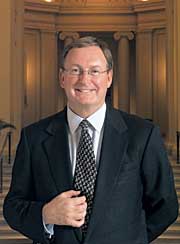Nearly a decade has passed since Malcom Rogers arrived in Boston to become one of the most controversial directors in history at the Museum of Fine Arts, Boston. Many supporters claim that Rogers's unorthodox vision has opened up the MFA, while dissenters say he has turned an educational institution into an entertainment venue. Let's take a moment to look at some of the last 10 years' highlights:
1992: Then director Alan Shestack lays off 21 employees and closes the Huntington Avenue entrance in a desperate attempt to cut $2 million from the budget.
1994: Rogers, overlooked for promotion at the National Portrait Gallery in London (for reasons of being "too academic"), applies and obtains director position at the Museum of Fine Arts in Boston. Shortly after arriving, he eliminates the department of exhibitions and put Katie Getchell, a 24-year-old secretary with an art history degree, in charge of coordinating shows through his office.
1995: Rogers cuts 83 jobs and reopens Hunington Avenue entrance.
1996: Gives photographer Herb Ritts first one person show in a prominent museum, which is criticized as a move to pull in more visitors with a blockbuster appeal. The Ritts show will go on to rank as one of the top 10 in the history of the Gund Gallery (outdrawing recent shows on Gainsborough, American folk art, and Gauguin).
1999: Since arriving, Rogers pursues goal of "one musuem". Convinced that the Museum was being dominated by uncooperative curators, Rogers merges serveral departments and fires 16. Among them are curators Jonathan Fairbanks, curator of American decorative arts and sculpture, and Anne Poulet, curator of European decorative arts and sculpture, who share a combined total of nearly 50 years of service to the museum. He merges the museum's European decorative arts and sculpture department with its paintings department, creating a new one called the "Art of Europe". He hires George T. M. Shackelford to take charge of that department, and Elliot Bostwick Davis was hired to run the corresponding "Art of the Americas" department.
2000: Capitalizing the fanaticism surrounding celecbrity culture, Dangerous Curves: Art of the Guitar goes on view, the first of many shows in this format to feature collectors. James Taylor narrates the audio tour, and guitars once played by Lennon and Hendrix are featured.
2003: The Museum loses $10 million after an attempt to turn the MFA's catalog business, Museum Enterprise Partners, into a for-profit company.
2004: MFA loans 21 Monets to The Bellagio Gallery of Fine Arts, at the Bellagio Casino in Las Vegas, for at least $1 million. Ralph Lauren's collection of vintage automobiles goes on display. Shackelford helps acquire an 1876 painting by Degas, estimated to be worth more than $20 million, the most expensive purchase in the Museum's history. Roger's lays off a total of 23 employees, curators and staff, to meet budget estimates for the next year.
2009 (and beyond): With increasing attendance and membership, Rogers cuts the ribbon on the massive MFA expansion project, designed by Foster and Partners. In 2004, the expected price tag was a modest $180 million. He hopes this highlight will be seen as the defining act of his career.
Story courtesy of Geoff Edgers in the September 12th edition of the The Boston Globe

